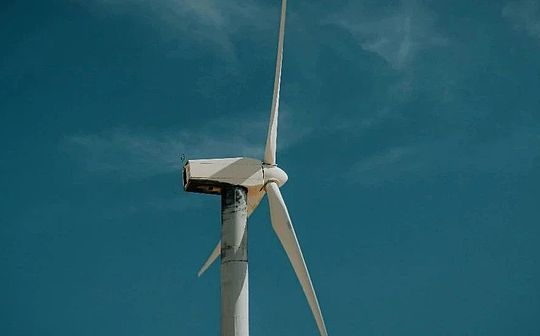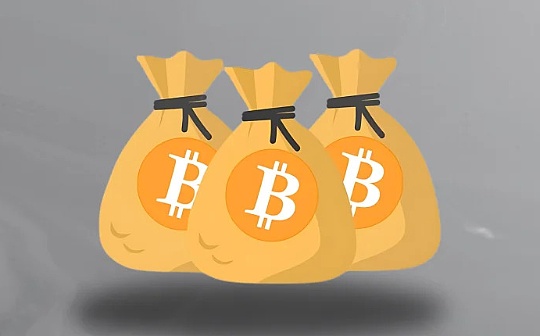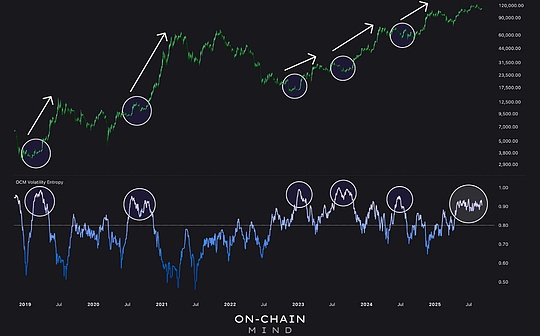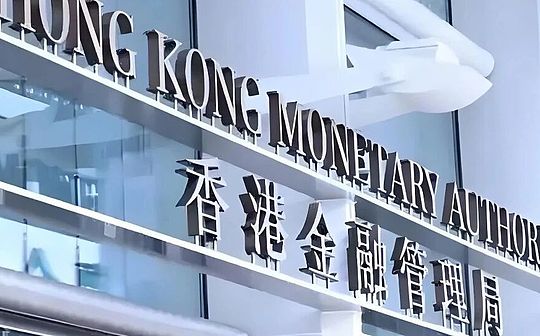
Source: Lawyer Liu Honglin
It turns out that I don’t understand electricity at all
During the May Day holiday, I drove through the Hexi Corridor, from Wuwei to Zhangye, Jiuquan, and then to Dunhuang.When driving on the Gobi Highway, wind turbines often appear on both sides of the road, standing silently on the Gobi Desert, which is very spectacular, like a Great Wall full of science fiction.

*Pictures are from the Internet
The Great Wall, a thousand years ago, guarded the frontiers and territory. Today, these fans and photovoltaic arrays guard the energy security of a country and the lifeblood of the next generation of industrial system.The sun and the wind have never been organized so systematically, embedded in national strategies, and become part of the sovereign capacity as they are today.
In the Web3 industry, everyone knows that mining is a very basic existence and is one of the most primitive and solid infrastructures of this ecosystem.Behind every round of bull and bear switching and every chain prosperity, the sound of mining machines running continuously is indispensable.Every time we talk about mining, what we talk about most is the performance and electricity price of mining machines – whether mining can make money, whether the electricity price is high, and where can we find low-cost electricity.
However, when I saw this long-distance road of electricity, I suddenly realized that I didn’t understand electricity at all:Where does it come from?Who can generate electricity?How does it teleport from the desert to thousands of miles away, who will use it, and how should it be priced?
This is my cognitive gap, and perhaps some friends will be equally curious about these issues.So, I plan to use this article to do some systematic tutoring, from China’s power generation mechanism, power grid structure, power trading, and then to terminal access mechanism, to re-understand the one-kWu electricity.
Of course, this is the first time lawyer Honglin has come into contact with this completely unfamiliar topic and industry. There are bound to be shortcomings and omissions. Please also ask your partners to give them more valuable opinions.
How much electricity does China have?
Let’s first look at a macro fact: According to the data released by the National Energy Administration in the first quarter of 2025, China’s power generation reached the end of 2024 in 2024.9.4181 trillion kWh,It increased by 4.6% year-on-year, accounting for about one-third of global power generation.What is this concept?The total annual electricity generation of the entire EU is less than 70% of that of China.This means that not only we have electricity, but we are in a dual state of “overpower” and “structural reconstruction”.
Not only does China generate a lot of power, but the way it generates has also changed.
As of the end of 2024, the total installed capacity of the country reached 3.53 billion kilowatts, an increase of 14.6% year-on-year., among which the proportion of clean energy has further increased.Photovoltaic new installed capacity140 million kilowatts, new wind power77 million kilowatts.In terms of proportion, China’s new photovoltaic installed capacity in 2024 accounted for 52% of the world and the new wind power installed capacity accounted for 41% of the world. In the global clean energy map, China is almost a “dominant role”.
This growth is no longer focused only on traditional energy-powered provinces, but is gradually tilting towards the northwest.Provinces such as Gansu, Xinjiang, Ningxia, and Qinghai have become “big new energy provinces” and are gradually transforming from “resource export place” to “main energy production force”.In order to support this transformation, China has deployed a national-level new energy base plan in the “Shagohuang” area:More than 400 million kilowatts of wind power and photovoltaic installed capacity are concentrated in deserts, Gobi and desert areas.Among them, the first batch of about 120 million kilowatts has been included in the “14th Five-Year Plan” special plan.

*The first in Asia, Dunhuang Shouhang Energy-saving 100 MW Molten Salt Tower Photothermal Power Station (Photo from the Internet)
At the same time, traditional coal-fired power has not completely withdrawn, but has gradually converted to peak-shaving and flexible power supplies.Data from the National Energy Administration shows that the national coal-fired power installed capacity increased by less than 2% year-on-year in 2024, while the growth rates of photovoltaic and wind power reached 37% and 21% respectively.This means that a pattern of “coal-based and green-based” is taking shape.
From the perspective of spatial structure, the overall balance of energy and electricity supply and demand in the country in 2024, but regional structural surplus still exists, especially in some periods of the Northwest region, where “more electricity can’t be used”, which also provides a realistic background for us to discuss later on “whether Bitcoin mining is an export method for power redundancy.”
A summary of this is:China now has no shortage of electricity, but what it lacks is “electricity that can be adjusted”, “electricity that can be absorbed” and “electricity that can make money”.
Who can send the electricity?
In China, power generation is not something you can do as long as you want. It does not belong to a purely market-oriented industry, but is more like a “franchise” with policy entrances and regulatory ceilings.
According to the “Regulations on the Management of Electric Power Business License”, all units that want to engage in power generation business must obtain the “Electric Power Business License (Power Generation)”. The approval entity is usually the National Energy Administration or its dispatched agency. Depending on the project size, region and technology type, its application process often involves multiple cross-evaluations:
-
Is it in line with national and local energy development plans?
-
Have land use, environmental impact assessment and water conservation approvals been obtained?
-
Do you have the conditions for accessing the power grid and absorbing space?
-
Is it technically compliant, funds in place, safe and reliable?
This means that in the matter of “power generation”, administrative power, energy structure and market efficiency are involved in the game at the same time.
At present, China’s power generation entities are roughly divided into three categories:
The first category is the five major power generation groups:State Energy Group, Huaneng Group, Datang Group, Huadian Group, and State Power Investment Corporation.These companies have mastered more than 60% of the country’s centralized thermal power resources and are also actively making arrangements in the new energy field.For example, the State Energy Group added more than 11 million kilowatts of wind power installed capacity in 2024, maintaining its leading position in the industry.
The second category is local state-owned enterprises:Such as Three Gorges New Energy, Beijing Energy Power, and Shaanxi Investment Group.Such enterprises are often bound to local governments, occupy an important role in local power layout, and undertake certain “policy tasks”.
The third category is private and mixed-ownership enterprises:Typical representatives include Longi Green Energy, Sungrow Power Supply, Tongwei Co., Ltd., Trina Solar, etc.These companies have shown strong competitiveness in photovoltaic manufacturing, energy storage integration, distributed power generation and other sectors, and have also obtained “indicator priority” in some provinces.
But even if you are a leading new energy company, it does not mean that you “build if you want to build a power plant.”The snap points here usually appear in three aspects:
1. Project indicators
Power generation projects need to be included in the annual local energy development plan and must obtain scenic project indicators.The allocation of this indicator is essentially a kind of local resource control – it is impossible for you to legally launch a project without the consent of the Local Development and Reform Commission and the Energy Bureau.Some regions also adopt the “competitive allocation” method, and select the best based on the degree of land saving, equipment efficiency, energy storage allocation, funding sources, etc.
2. Power grid access
After the project is approved, you must apply for access system evaluation from the State Grid or the Southern Power Grid.If the local substation capacity is full or there is no transmission channel, the project you built is useless.Especially in areas where new energy concentrations such as the Northwest, it is normal to have difficulty in access and dispatching.
3. Consumption ability
Even if the project is approved and there are lines, if the local load is insufficient and the cross-regional channels are not opened, your electricity may be “no one available”.This leads to the problem of “abandoning wind and light”.In its 2024 notice, the National Energy Administration pointed out that some cities and cities have even suspended access to new new energy projects due to the concentrated project launch and far exceeding the load.
Therefore, “whether it can generate electricity” is not only a matter of the company’s capabilities, but also a result of the joint decision of policy indicators, the physical structure of the power grid and market expectations.Against this background, some enterprises have begun to turn to new models such as “distributed photovoltaic”, “park self-power supply”, and “industrial and commercial energy storage coupling” to avoid centralized approval and absorption bottlenecks.
From the perspective of industry practice, this three-layer structure of “policy access + engineering threshold + dispatch negotiation” determines that China’s power generation industry still belongs to the “structural access market”. It does not naturally exclude private capital, but it is also difficult to allow pure market-driven.
How to transport electricity?
In the field of energy, there is a widely circulated “electricity paradox”: resources are in the west and electricity is in the east; electricity is generated but cannot be sent.
This is a typical problem with China’s energy structure: the northwest is rich in sun and wind, but the population density is low and the industrial load is small; the east is economically developed and consumes a lot of electricity, but the local new energy resources can be developed very limited.
What should I do?The answer is: constructionUltra-high voltage transmission (UHV), use the “electric highway” to transport the wind and photoelectricity in the west to the east.

As of the end of 2024, China has put into operation with UHV linesThere are 38 AC lines, including 18 AC lines and 20 DC lines.The DC transmission project is particularly critical because it can achieve low loss and large capacity directional transmission at extremely long distances.For example:
-
“Qinghai-Henan” ±800kV DC line:It is 1,587 kilometers long and transmits power to the Central Plains urban agglomeration;
-
“Changji-Guquan” ±1100kV DC line:It is 3293 kilometers long, setting a global record of double transmission distance and voltage level;
-
“Northern Shaanxi-Wuhan” ±800kV DC line:It serves the energy base in northern Shaanxi and the industrial hinterland of central China, with an annual transmission capacity of over 66 billion kilowatt-hours.
Each ultra-high voltage line is a “national-level project” and is unified by the National Development and Reform Commission and the Energy Administration. State Grid or Southern Power Grid is responsible for investment and construction.These projects often invest hundreds of billions of yuan, with a construction cycle of 2-4 years. They often require cross-provincial coordination, environmental protection assessment and implementation and relocation cooperation.
Then why do you need to use ultra-high voltage?In fact, behind it is a problem of resource redistribution:
1. Redistribution of space resources
China’s scenic resources, population and industry are seriously misaligned.If the spatial differences cannot be made through efficient power transmission, all the slogans of “West-to-East Power Transmission” are empty talk.Ultra-high voltage uses “transmission capacity” to replace “resource endowment”.
2. Electricity price balance mechanism
Due to the large difference in electricity price structures between the resource and consumer ends, ultra-high voltage transmission has also become a tool for realizing regional electricity price difference adjustment.The central and eastern regions can obtain relatively low-priced green electricity, while the western regions can realize energy monetization benefits.
3. Promote the consumption of new energy
Without power transmission channels, it is easy to see a situation where wind and light abandonment is abandoned in the northwest region.Around 2020, the power abandonment rate in Gansu, Qinghai and Xinjiang once exceeded 20%.After the UHV is completed, these figures have dropped to less than 3%, which is the structural relief brought about by the improvement of transmission capacity.
It has been made clear at the national level that ultra-high voltage is not only a technical issue, but also an important pillar of the national energy security strategy.In the next five years, China will continue to lay out dozens of ultra-high voltage lines in the “14th Five-Year Power Development Plan”, including key projects such as Inner Mongolia to Beijing-Tianjin-Hebei, Ningxia to the Yangtze River Delta, and further realize the unified scheduling goal of “one network in the country”.
However, it should be noted that although UHV is good, there are two long-term controversial points:
-
High investment and slow recycling:The investment in a ±800kV DC line often exceeds 20 billion yuan, and the return cycle exceeds 10 years;
-
Difficulty in cross-provincial coordination:UHV needs to travel through multiple administrative regions and put forward high requirements for the coordination mechanism between local governments.
These two issues determine that UHV is still a “national project” rather than a market infrastructure under the free decision-making of enterprises.But it is undeniable that in the context of rapid expansion of new energy and intensified regional structural mismatch, ultra-high voltage is no longer an “optional”, but a necessary option for the “Chinese version of the energy Internet”.
How to sell electricity?
After generating power and sending out power, the next thing is the core issue:How to sell electricity?Who will buy it?How much is it once?
This is also the core link that determines whether a power generation project is profitable.In the traditional planned economic system, this problem is very simple: power generation in the power plant → selling to the State Grid → unified dispatch of the State Grid → users pay electricity bills, everything is priced according to the state.
However, after the large-scale grid connection of new energy, this model has been completely lost.The marginal cost of photovoltaic and wind power is close to zero, but their output is volatile and intermittent, and it is not suitable for inclusion in power planning systems with fixed electricity prices and rigid supply and demand.Therefore, from “can it be sold” to the new energy industry’s life and death line.
According to the new regulations implemented in 2025, all new new energy power generation projects across the country willCompletely cancel the fixed electricity price subsidy.Must participate in market-oriented transactions, including:
-
Medium- and long-term contract transactions:Similar to “pre-sale electricity”, power generation companies directly sign contracts with power users to lock in a certain period of time, price and electricity;
-
Spot market transactions:According to real-time fluctuations in power supply and demand, electricity prices may change every 15 minutes;
-
Auxiliary Services Market:Provide grid stability services such as frequency regulation, voltage regulation, and backup;
-
Green Power Trading:Users voluntarily purchase green power with a green power certificate (GEC);
-
Carbon market trading:Power generation companies can gain additional benefits from reducing carbon emissions.
At present, multiple power trading centers have been established across the country, such as Beijing, Guangzhou, Hangzhou, Xi’an and other places.Electric Power Trading Center Co., Ltd., uniformly responsible for market matching, electricity confirmation, electricity price settlement, etc.
Let’s look at an example of a typical spot market:
During the summer heat of 2024,Guangdong Electric Power Spot MarketExtreme fluctuations occurred, with the electricity price in the valley section as low as 0.12 yuan/kWh and the peak section as high as 1.21 yuan/kWh.Under this mechanism, if new energy projects can be flexibly dispatched (such as equipped with energy storage), they can “storage electricity at low prices and sell electricity at high prices” to obtain huge price difference returns.
In contrast, projects that still rely on medium- and long-term contracts but lack peak-shaving capabilities can only sell electricity at a price of around 0.3-0.4 yuan per kilowatt-hour, and are even forced to go online at zero prices during some power abandonment periods.
As a result, more and more new energy companies have begun to investSupporting energy storage, on the one hand, it is used for grid scheduling response, and on the other hand, it is used for price arbitrage.
In addition to electricity price income, new energy companies also have several possible sources of income:
1. Green Power Certificate (GEC) transaction.In 2024, Jiangsu, Guangdong, Beijing and other provinces and cities have launched GEC trading platforms, and users (especially large industrial enterprises) purchase GEC for purposes such as carbon disclosure and green procurement.According to data from the Energy Research Association, the transaction price range of GEC in 2024 is 80-130 yuan per MWh, equivalent to about 0.08-0.13 yuan/kWh, which is a major supplement to traditional electricity prices.
2. Carbon market trading.If new energy projects are used to replace coal-fired power and are included in the national carbon emission trading system, “carbon assets” benefits can be obtained.As of the end of 2024, the national carbon market price was about 70 yuan/ton CO₂, and the emission reduction of about 0.8-1.2 kilograms per kilowatt-hour of green electricity was reduced, and the theoretical income was around 0.05 yuan/kWh.
3. Peak and valley electricity price adjustment and demand response incentives.Power generation companies sign power consumption regulation agreements with high-energy-consuming users to reduce load during peak periods or send back power to the power grid, and additional subsidies can be obtained.This mechanism is being promoted rapidly in the pilot projects in Shandong, Zhejiang, Guangdong and other places.
Under this mechanism, the profitability of new energy projects no longer depends on “how much electricity can I generate”, but:
-
Can I sell it for a good price?
-
Do I have a long-term buyer?
-
Can I cut peaks and fill valleys?
-
Do I have energy storage or other adjustment capabilities?
-
Do I have green assets that can be traded?
The project model of “grabbing indicators and relying on subsidies” in the past has come to an end. In the future, new energy companies must have financial thinking and market operation capabilities, and even manage power assets as carefully as they do derivatives.
A summary of this is:The “power selling” link of new energy is no longer a simple buying and selling relationship, but a systematic project that uses electricity as a medium and plays in concert with policies, markets, carbon rights and finance.
Why are there any electricity abandonment?
For power generation projects, the biggest risk is never whether the power station can be built, but that “it cannot be sold after it is completed.”And “power abandonment” is the silent but deadliest enemy in this link.
The so-called “power abandonment” is not that you do not generate electricity, but that the power you emit has no users, channels, and room for dispatch, so you can only waste it.For a wind power or photovoltaic company, abandoning electricity not only means a direct loss of income, but may also affect subsidy application, power accounting, green certificate generation, and even affect subsequent bank ratings and asset revaluation.
According to statistics from the Northwest Supervision Bureau of the National Energy Administration, the wind power disposal rate in Xinjiang once reached 16.2% in 2020, and photovoltaic projects in Gansu, Qinghai and other places also experienced a power disposal rate of more than 20%.Although this data has dropped to 2.9% and 2.6% respectively by the end of 2024, in some areas and periods, abandoning power is still a reality that the project party cannot escape – especially in typical scenarios with high light and low load at noon, a large amount of photovoltaic power is “pressed” by the dispatching system, which means that it is gray when it is emitted.
Many people think that the power is abandoned because of “not enough electricity”, but in essence it is the result of an imbalance in system scheduling.
First of all, there is the physical bottleneck: in some resource-concentrated areas, the capacity of the substation has long been saturated, and the grid access has become the biggest limit, and the project can be approved but cannot be accessed.The second is the rigid scheduling mechanism.China is still using the stability of thermal power units as the scheduling core. The uncertainty of new energy output has allowed the dispatching units to habitually “restrict access” to avoid system fluctuations.Coupled with the delay in consumption coordination between provinces, although many electricity is theoretically “someone wants it”, they are “can’t send it out” in administrative processes and inter-provincial channels, and they can only be discarded in the end.At the market level, there is another lagging rule system: the spot power market is still in its early stages, the auxiliary service mechanism and price signal system are far from perfect, and the energy storage regulation and demand response mechanism have not yet formed a scale in most provinces.
The policy level is actually not without response.
Starting from 2021, the National Energy Administration has included the “New Energy Consumption Capacity Assessment” in the pre-project approval, requiring local governments to clarify local “carryable indicators”. In many policies in the “14th Five-Year Plan”, it proposed to promote the integration of source, network, load storage, build local load centers, improve spot market trading mechanisms, and forcefully allocate energy storage systems to cut peaks and fill valleys.At the same time, governments in many places have introduced a “minimum consumption ratio” responsibility system, clarifying that the average annual utilization hours of new energy grid-connected projects shall not be lower than the national baseline, and forcing the project parties to consider adjustment methods in advance.Although these measures are in the right direction, the implementation progress is still significantly lagging. In many cities where new energy installations are soaring, problems such as lagging power grid transformation, slow energy storage and construction, and unclear regional scheduling ownership are still common, and the pace of institutional promotion and market coordination are still not matched.
More importantly, behind the abandonment of electricity is not a simple “economic inefficiency”, but a conflict between resource space and institutional structure.The northwest has abundant power resources, but its development value depends on cross-provincial and cross-regional power grid transmission and scheduling systems, while China’s current administrative divisions and market boundaries are highly separated.This has led to a large amount of “technically available” electricity that has no place to be placed in the system, becoming a kind of passive redundancy.
Why can’t China’s electricity be used for cryptocurrency mining?
While a large amount of electricity that is “technically available and institutionally has nowhere to be placed” is idle, an originally marginalized electricity use scenario—Cryptocurrency Mining, in the past few years, it has been appearing in the form of underground and guerrilla style, and has regained the realistic position of “structurally needed” in some areas.
This is not accidental, but a natural product of some kind of structural gap.As a real-time computing power behavior with high power consumption and low continuous interference, cryptocurrency mining is naturally compatible with the power generation projects that abandon wind and light.The mine does not require stable scheduling guarantees, does not require the power grid to be connected, and can even actively cooperate with the scheduling to cut peaks and fill valleys.More importantly,It can convert electricity that no one wants outside the market into on-chain assets, thus forming a path of “redundant monetization”.
From a purely technical perspective, this is an improvement to energy efficiency; but from a policy perspective, it is always in an awkward position.
The main government of China has stopped mining in 2021. The core consideration is not the electricity itself, but the behind it.Financial risks and industrial orientation issues.The former is related to the opacity of the path of crypto assets, which can easily cause regulatory problems such as illegal fundraising and cross-border arbitrage; the latter involves the industry evaluation of “high energy consumption and low output”, which does not conform to the current strategic theme of energy conservation and carbon reduction.
in other words,Whether mining is a “reasonable load” does not depend on whether it absorbs power redundancy, but on whether it is incorporated into the “acceptable structure” in the policy context.If it still exists in an opaque, non-compliant and uncontrollable way, it can only be classified as a “gray load”; but if it can limit the area, limit the power supply, limit the electricity price, limit the chain use, and be designed as a special energy export mechanism within the compliance framework, it may not necessarily not be able to become a part of the policy.
This kind of redesign is not without precedent.Internationally, Kazakhstan, Iran, Georgia and other countries have long included “computer load” into the power balance system, and even guided mines to bring digital assets such as USDT or USDC to the country as a source of alternative foreign exchange reserves.In the energy structure of these countries, mining is redefined as a “strategic adjustable load”, serving both the power grid regulation and the reconstruction of the monetary system.
Although China cannot follow this radical method, can it be restored locally, limitedly and conditionally?Especially in the stage where the power abandonment pressure continues and green power cannot be fully marketed in the short term, using mines as a transition mechanism for energy consumption and Bitcoin as an on-chain asset reserve for closed allocation may be closer to reality than one-size-fits-all clearance, and it can better serve the country’s long-term digital asset strategy.
This is not only a re-evaluation of mining, but also a redefinition of the “value boundary of electricity”.
In the traditional system, the value of electricity depends on who buys and how to buy it; in the on-chain world, the value of electricity may directly correspond to a piece of computing power, an asset, and a path to participate in the global market.While the country is gradually building AI computing power infrastructure, promoting the East Digital and West Computing Project, and building a digital RMB system, should we also leave a technically neutral, compliant and controllable channel for a “on-chain energy monetization mechanism” on the policy drawings?
Bitcoin mining may be the first time that China has converted energy into digital assets in a state of “no middleman” – this problem is sensitive, complex, but cannot be avoided.
Conclusion: The ownership of electricity is a realistic multiple-choice question
China’s power system is not behind.Wind energy covers the Gobi Desert, sunshine covers the sand dunes, ultra-high voltage travels through thousands of miles of wasteland, sending a kilowatt-hour of electricity from the frontier to the high-rise buildings and data centers in eastern cities.
In the digital age, electricity is no longer just a fuel for lighting and industry. It is becoming the infrastructure for value calculation, the root of data sovereignty, and the most important variable to be ignored when reorganizing the new financial order.Understanding the flow of “electricity” is to some extent, understanding how the system sets qualification boundaries.The landing point of kilowatt-hour of electricity was never decided by the market naturally, and there were countless decisions behind it.Electricity is not evenly, it always flows to the allowed person, the identified scene, and the accepted narrative.
The core of the Bitcoin mining dispute is never whether it consumes electricity, but whether we are willing to admit that it is a “reasonable existence” – a use scenario that can be included in national energy dispatch.As long as it is not recognized, it can only wander in the gray and run in the cracks; but once it is recognized, it must be placed institutionally – with boundaries, conditions, right of interpretation, and regulatory caliber.
This is not about loosening or blocking an industry, but about a system’s attitude towards “unconventional load”.
And we are standing at this fork, watching the choice happen quietly.
References
[1] China Government Network, “National Electric Power Industry Statistics in 2024”, January 2025.
[2] IEA, “Renewables 2024 Global Report”, January 2025.
[3] National Energy Administration, Appendix to the “2024 Annual Energy Operation Report”.
[4] National Development and Reform Commission Energy Institute, “Progress in the Construction of the “Shagohuang” Scenic Base”, December 2024.
[5] National Development and Reform Commission, “Interim Measures for the Management of Renewable Energy Power Generation Projects”, 2023.
[6] Reuters, “China’s UHV Transmission System Evaluation Report”, May 2025.
[7] Infolink Group, “Analysis of China’s New Energy’s cancellation of fixed electricity price subsidies”, March 2025.
[8] National Power Dispatch Center, “North China Electric Power Spot Market Operation Notice (2024)”.
[9] REDex Insight, “China’s Unified Power Market Roadmap”, December 2024.
[10] China Electric Power Enterprise Federation, Attachment of the “2024 Annual Electric Power Industry Report”.
[11] Northwest Supervision Bureau of the National Energy Administration, “Notice on the Northwest Wind and Light Abandonment”, December 2024.
[12] Energy Research Association, “Pilot Observation Report on Green Power Certificate Transaction”, January 2025.
[13] CoinDesk, “Analysis of Adjustment of Mining Policy in Kazakhstan”, December 2023.








